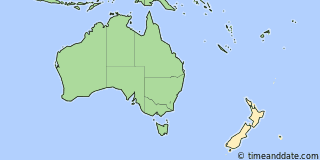2025年4月6日 (日), 3時00分
| Country: | New Zealand |
|---|---|
| Abbreviations: | NZ, NZL |
| Other Name: | Aotearoa |
| Capital: | Wellington |
| Time Zones: | 2 (Main Country) |
| Total Time Zones: | 3 (with dependencies) |
| Dial Code: | +64 |
4月2日 (日)
Back 1 hour
2023年4月2日 (日) - Daylight Saving Time Ended
When local daylight time was about to reach
2023年4月2日日曜日, 3時00分00秒 clocks were turned backward 1 hour to
2023年4月2日日曜日, 2時00分00秒 local standard time instead.
Sunrise and sunset were about 1 hour earlier on 2023年4月2日 (日) than the day before. There was more light in the morning and less light in the evening.
Also called Fall Back and Winter Time.
More info:
Australia & New Zealand End DST
9月24日 (日)
Forward 1 hour
2023年9月24日 (日) - Daylight Saving Time Started
When local standard time was about to reach
2023年9月24日日曜日, 2時00分00秒 clocks were turned forward 1 hour to
2023年9月24日日曜日, 3時00分00秒 local daylight time instead.
Sunrise and sunset were about 1 hour later on 2023年9月24日 (日) than the day before. There was more light in the evening and less light in the morning.
Also called Spring Forward, Summer Time, and Daylight Savings Time.
More info:
Australia & New Zealand Start DST
When Does DST Start and End in NZ?
Daylight Saving Time (DST) in New Zealand starts on the last Sunday in September and ends on the first Sunday in April.
Daylight Saving Time in Dependencies of New Zealand
| Dependency | Type | Daylight Saving Time Period |
|---|---|---|
| Tokelau | Territory | No Daylight Saving Time |
Daylight Saving Time History in New Zealand
- New Zealand first observed Daylight Saving Time in 1927.
- New Zealand has observed DST for 72 years between 1927 and 2025.
- Previous time with no Daylight Saving Time was 1973.
- See Worldwide DST Statistics
The Inventors of DST
New Zealand was the home of one of the pioneers of DST, but the seasonal change was not adopted in the country before 1927.
The history of DST in New Zealand started more than 20 years earlier. In 1895, the scientist George Vernon Hudson presented a paper to the Wellington Philosophical Society advocating seasonal time adjustments. The society members ridiculed his idea. However, in 1909, the parliamentarian Thomas Sidey proposed to move the clocks 1 hour forward in New Zealand’s summer period to allow for an extra hour of daylight in the evenings.
Confusing Changes
The Summer Time Act 1927, set the clocks forward 1 hour, but the measure was unpopular. The Summer Time Act 1928 reduced the time change to 30-minutes instead. After the Summer Time Act 1929 went into effect, the DST period lasted from the second Sunday in October to the third Sunday in March. In 1933, it was extended to run from the first Sunday in September to the last Sunday of April.
In 1941, during World War II, clocks were set forward 30 minutes, increasing New Zealand's offset from GMT to 12 hours. The time change was made permanent by the Standard Time Act 1945.
Modern DST in NZ
New Zealand's current DST schedule was established by the Time Act 1974. The measure proved so popular that the start and end dates of the DST period were extended several times. Following the Daylight Time Order 1990, DST ran from the first Sunday in October to the third Sunday in March.
In 2007, New Zealand’s Minister of Internal Affairs, Rick Barker, announced that the DST schedule was to be extended further. The decision was made after a survey and petition found that people favored an extended DST period. DST in New Zealand is today observed from the last Sunday in September to the first Sunday in April.
